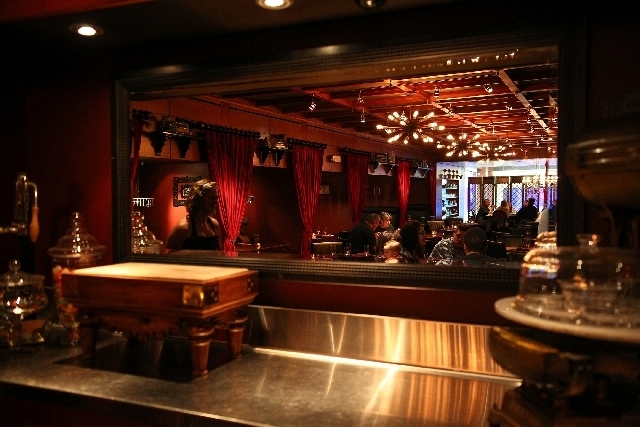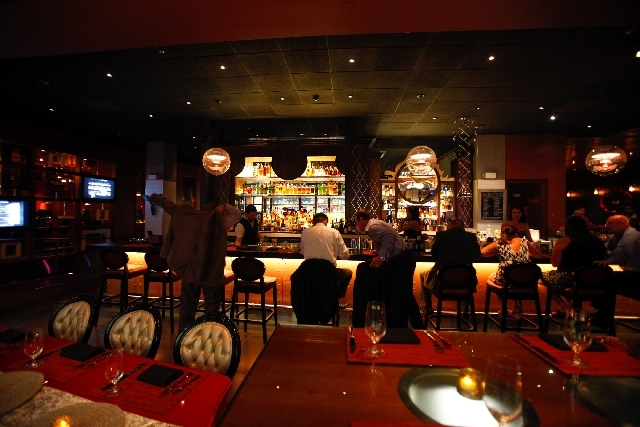For Las Vegas chefs, casual doesn’t mean inferior
They came, they saw, they conquered. And now they’re trading in the tuxes for Hawaiian shirts.
In a manner of speaking, of course.
The parade of celebrated chefs opening restaurants in Las Vegas has slowed in recent years, probably as much because of saturation as the dismal economy. But among those who already are here, much activity is afoot.
Rick Moonen closed his rm seafood fine-dining restaurant at Mandalay Bay and replaced it this month with Rx Boiler Room, a steampunk-themed spot with a menu inspired by comfort foods.
Shawn McClain, who has Sage at Aria, this month added Five50 Pizza Bar in the same hotel.
Michael Mina closed Nobhill and Seablue at MGM Grand and in June opened Michael Mina 1842, named for the year that pilsner was created and offering a “playful” menu.
And Bradley Ogden, who had an eponymous restaurant at Caesars Palace (which was replaced at the end of 2012 by the casual Gordon Ramsay Pub & Grill) has resurfaced in the ’burbs, opening Hops & Harvest at Tivoli Village in June.
So what gives? Is this an indicator of the end of fine dining in Las Vegas?
The reasons for the new ventures are many and varied, but that doesn’t appear to be one of them.
“There’s always going to be a need for fine dining,” Moonen said.
That said, “in Las Vegas,” he added, “I think fine dining is more than covered by the three-star Michelin French chefs” who include Joel Robuchon at MGM Grand, Guy Savoy at Caesars Palace, Alain Ducasse at Mandalay Bay and Pierre Gagnaire at the Mandarin Oriental. Such ultrahigh-end restaurants, he said, are viewed as loss leaders by the casinos that house them.
“I can’t afford that,” Moonen said. “I own my business.”
Although fine dining isn’t going away, it appears we are going to be seeing a little less of it.
“I think it was driven by the economy shift,“ Moonen said of the recent wave of changes. “Fine dining started to fall out of people’s budgets.”
McClain said: “The market is changing. Fine dining will always exist, but there’s always ebbs and flows. The market’s going to follow those trends. Since the downturn in the economy three, four years ago, the trend is toward more casual dining.”
And, it seems, fine dining and casual dining aren’t mutually exclusive.
“For us, it’s an adjunct to fine dining,” said Patric Yumul, president of the Mina Group. “It’s an opportunity to meet a different demographic with guests and have relationships with more people.”
“Casual,” they point out, needn’t equate to “inferior.”
“I think for me,” McClain said, “and people who put a lot of effort into one part of our industry, the standards for us in general remain the same no matter what we’re doing. I’m still using a forager, still buying from the market, have the same philosophy in how the food is produced. We teach cooks to put their heart and soul in things.”
Yumul agreed.
“Ultimately, what we’ve found is we’re able to have the same intensity and same passion about product and service, but we’re able to trade down the price point a little bit,” he said. “It’s an opportunity to have a chef type of experience that normally they might not have been able to, because it’s a little bit out of their budget. The pub concept falls within their budget, and they really feel they got to treat themselves, even though it isn’t a treat-yourself price point.”
McClain acknowledged that the path was paved in Las Vegas by Hubert Keller, who opened Burger Bar at Mandalay Place in 2004 and traded the fine-dining Fleur de Lys for the more casual Fleur at Mandalay Bay in early 2011, and Todd English, who opened Todd English P.U.B. in Crystals at CityCenter in 2010.
“Really from top to bottom, from the great chefs that we all have learned from, they’ve put their stamp” on the modern casual concept, he said. “Hubert Keller, just the way that he approaches the hamburger, has brought the level of detail — where the meat is sourced from, how it’s put together. It’s higher-quality casual food. We can thank a lot of chefs for bringing that expertise. Really, our job is to keep those same standards, no matter what aspect of dining.”
Keller said the Fleur conversion, which also involved a more open front to the space, has been “amazing.”
“When they realize the style of the restaurant, I think people really are not intimidated,” he said. “We were able to reach numbers that before were not even thinkable.”
Keller sees a younger clientele for dining in general, and said it’s definitely discriminating.
“They want to know about the food — where it comes from,” he said. “It’s totally exciting.”
And these younger diners are changing the business in other ways, he said.
“If you think that just yesterday, in some of the restaurants you would write down on the menu, ‘You can’t use your cellphone,’ ” Keller said. “Now, if you don’t let them tweet right away what they’re eating, they’re not going to walk in. They’re going to be insulted. That whole world has changed dramatically.”
Keller said the casual approach also lets the customer have more control over things such as portion and check sizes.
“You can keep ordering,” adding dishes as the meal progresses, he said. “Nobody’s going to look at you weird. And you can spend the money if you wish, or you can keep it lower.”
Moonen said his new restaurant, where the menu includes such whimsical choices as bacon-wrapped bacon topped with a quail egg, is “much more moderate,” with small plates in tapas-style portions.
“You can try a couple of little appetizers, get a smaller-sized entree and the dessert,” if desired, he said. “At the end of the day, you can control your experience.”
Entertainment also is a factor, they said.
“This is Las Vegas; it’s about entertainment, it’s about the experience,” Moonen said. “There needs to be some sort of drama,” which in the case of Rx Boiler Room is provided largely by the funky industrial-Victorian design, but also by liquid-nitrogen fog, bubbles from carbonating machines and smoke from “these little smokers,” much of it employed in the bar area.
“It’s a little bit more theater, more entertainment,” he said. “It’s interactive. It’s a place to hang out.”
Ogden said he would return to the Strip if the right opportunity came up, but that the opening near Summerlin, where he lived for four years, made sense from a business standpoint.
“They actually came to me,” he said of his business partners. “This particular location came up. They have some other restaurants in that area. We looked at the property and thought this could be a really good venture for us, especially with my new company,” Bradley Ogden Hospitality, which is opening restaurants in Houston and in California’s Bay Area.
A big difference between his restaurant on the Strip and the one in Tivoli Village, he said, is staffing needs.
“That was meant to be a world-renowned restaurant; then you had to staff it accordingly and have the support,” he said. “This venue is really more of just a casual place to go. Everything’s from scratch, everything’s natural — that we can get. The difference is price structure, still trying to keep the quality. What I’m known for is this organic American food, but it’s more of a pub-type atmosphere.”
Atmosphere is a big factor for McClain, too.
“Our biggest goal,” he said, “is how to capture the soul of that European or East Coast pizzeria, the nostalgia feel. How do you create the nostalgia part and yet create a restaurant that does even more,” with such offbeat, updated takes like crostini topped with octopus salad.
“It’s pushing things forward a little bit,” he said. “ ‘Wow, that was a great pizza, but it was a great restaurant experience as well.’ ”
Which, Yumul said, can pay off in other ways.
“It’s been great at the pub,” he said. “It’s so funny, because we keep hearing they had a great time, they loved the experience, and now they want to try our other restaurants.”
Contact reporter Heidi Knapp Rinella at hrinella@reviewjournal.com or 702-383-0474.






























